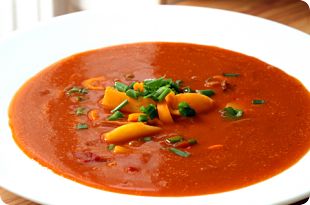A Well-Known Study Gives Unexpected Insight
Colds, flu, and all manner of upper respiratory infections blossom in winter. Modern medicine has no effective cure for the patient’s misery. Some drugs can temporarily help with symptoms, but may have unwanted side effects that make things worse in the long-run.
So what is a desperate sufferer or their family member to do? Folk cures abound. Chicken soup is reputed to be useful in alleviating cold symptoms. In fact, a scientific study published in 2000 in the peer-reviewed medical journal Chest is often cited to support the idea that chicken soup has real clinical effects. The action the study authors see as most beneficial in helping with cold misery was the demonstrated anti-inflammatory power of the soup.
With the advent of cold and flu season, I decided to revisit the Chest study to see if the supposed beneficial effect of chicken soup would be duplicated or improved by plant-based soups.
The study authors started out making their soup with only chicken, then after some cooking time added lots of excellent vegetables – onion, sweet potato, parsnips, turnips, carrots, celery, parsley. They tested the soup for a beneficial effect on dampening over-active immune system cells (which are responsible for inflammation) periodically as they cooked it.
Here’s the whole story of the startling findings. Before vegetables were added, the chicken broth had no anti-inflammatory activity. Right after vegetables were placed in the pot, the broth acquired potent anti-inflammatory impact on human immune system cells. After the vegetables cooked for a while (exact times are not given in the article, but total cooking time was 2 hours and 15 minutes), they lost some of their anti-inflammatory power.
So, in this widely touted article, it turns out the findings indicate that lightly cooked vegetable soup is a powerful weapon to relieve cold symptoms. The study authors suggest other effects that soup may have in shortening colds and making the patient feel better.

An appetizing array of nourishing vegetables powers the cold-busting properties of soup. Can you imagine soup without vegetables? That would be like air without oxygen.
All these are accomplished as effectively, if not more powerfully, by vegetable soup than by soup with animal broth.
• Mechanical effect of the heat in loosing mucus. In other words, if you have a cold, eat your soup while it is hot and inhale the steam as you eat.
• Hydrating effect in replacing fluids lost to illness. For this to work, eat soup with lots of broth. Best to avoid salt, which will increase your need for fluids. Flavor your soup with nutrient-packed herbs and spices instead. For example, go for garlic, ginger, black pepper, or curry, or any other flavoring you like, to replace the routine salt.
• Medically active nutrients in the vegetables. Of course, this observation by the study authors indicates vegetable-based soup would be vastly superior to animal-based soup in speeding recovery from respiratory infections.
• Antioxidant activity of the soup. Again, the potent vitamins and phytochemicals in plants will win against any animal food in getting rid of the free radicals that can damage your cells, both when you have a cold or any other time.
So what kind of soup is best for colds, flu, and other respiratory problems? The Chest article, not to mention thousands of other studies of the beneficial might of whole plant foods, suggests you give lightly cooked vegetable soup thumbs up. Cook the vegetables until they are just tender. Usually this is about eight to ten minutes.
Dried beans, brown rice, barley, sweet potatoes, potatoes, and several other potential soup ingredients have to cook more than ten minutes, and some people like onion with longer cooking times. So when those ingredients are about ten minutes from being done, add your quick cooking vegetables, such as carrots, celery, broccoli, string beans, mushrooms, green onions, cabbage, or whatever others you are using. Spinach really doesn’t even need to cook. Just let it wilt in the hot broth when the soup is done.
Your soup base can be homemade or commercial vegetable, tomato, or mushroom broth. You can also cook in plain water, and add some miso for flavor after turning the soup off (you don’t want to boil miso). Be liberal in your use of herbs and spices. Search the internet or any good vegan cookbook for recipe ideas.
Eat your vegetable soup, and see if you feel better faster when you are sick. Eat this way every day, and you might get so healthy that colds don’t even get you down nearly as often as they used to. Don’t you love it when science supports common sense.
If you want to learn more about vanquishing colds with soup, check out this post on another power plant ingredient you can add to your soup: How To Make the Best Soup for a Cold Even More Powerful. You might also want to try out this easy, tasty recipe for a filling soup that is tough on colds.
Intrigued? Now you can use our Whole Foods Blog Finder to target informative, fun postings on plant-based nutrition. Quick information at no cost!
Blog posting by Janice Stanger, Ph.D. Janice authored The Perfect Formula Diet, the smart person’s nutrition book built on sustainable food choices. Enjoy six kinds of whole foods for permanent, hunger-free weight loss and health.
Tags: cold, flu, getting healthy, Janice Stanger, Plant-based nutrition, respiratory infection, soup, vegetables, whole foods






Can you tell me if a soup made in my vitamix will have the same effect? It would process to heat about 6 minutes. Some people tell me the vitamix process destroys a lot of the vitamins/health effects. I sure hope not!
Thank you!
Judy
I love soup all the time! Soup is one of my favorite dishes and it is so easy to make! A good bowl of miso soup with fresh veggies and grated ginger takes about 15 minutes max. Glad to know I’m eating lots of great antioxidants!